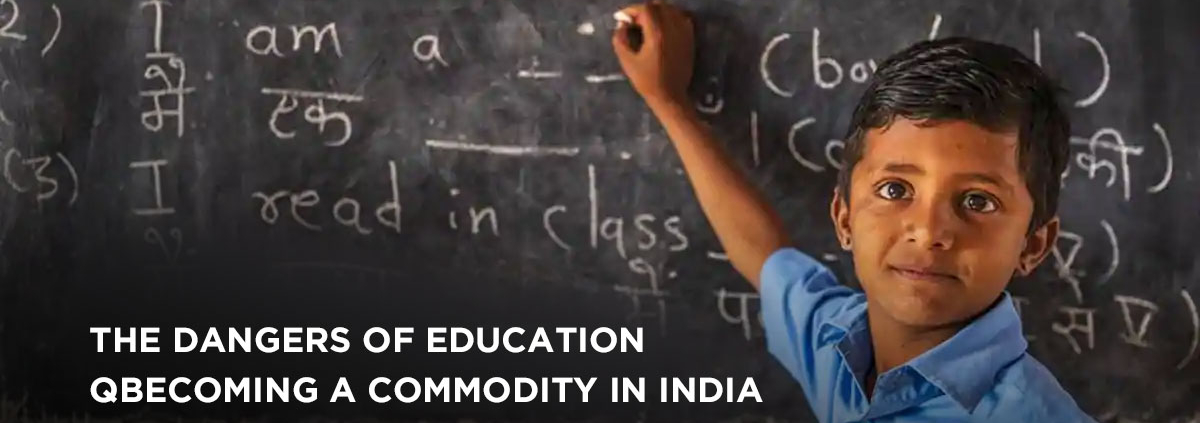According to Merriam-Webster dictionary, a ‘commodity’ is something that is subject to ready exchange or exploitation within a market.
By this definition, education, as a commodity, can be bought and sold in the same way cooking oil can be bought and sold. Except, in India, extreme economic inequality means that commodifying education will price out a vast majority of Indians from good schools — the same way a large number of people cannot afford healthy, high-grade oils for cooking and have to make-do with low-grade palm oil.
But, if we want to stop commodification of education, is leaving the schools in the hands of the government a viable solution?
In a country like India, with large population and systemic challenges, efficient standardization is a tall order as it is. Government and public schools are often under-regulated and underfunded, leading to many secondary ill-effects such as bad staffing, poor salaries for teachers and lack of clear direction. Parents are therefore understandably discouraged from opting for government schools, fearing stunted academic growth and lack of future opportunities. So, I believe it is rational that parents are given the choice of how and where their children’s schooling happens. This “choice” is what the new National Education Policy (2020) promises — in terms of opportunities, subjects and accessibility. But, is NEP what it purports to be?
Corporatisation in the name of quality
Among other things, NEP eliminates barriers for FDIs and foreign universities to enter India’s educational sector, which boasts a sizable aggregate demand. Also, the government will facilitate the entry, through incentives such as subsidized land deals, tax benefits, etc., citing “public interest”. Such initiatives borrow rationale from a questionable notion that advocates for privatization as the answer to deep-rooted gaps in India’s educational system. But there are reports from reliable organizations arguing otherwise, particularly a collaborative report from the UNESCO and the World Bank, which suggests expansive policies of prestigious universities without the promise of quality education(1).
Since deregulation is the primary incentive for foreign universities to “set up shop” in India, the government cannot ensure equal opportunities for all of its citizens. In other words, NEP is, at best, a tool to further the corporate-capitalism cause. One way to explain the possible outcome is: A student graduating from a private medical school has massive student loans to repay. Since corporate hospitals pay better than public ones, the doctor is drawn towards the former, at the prospect of clearing loans sooner. And in doing so, becomes subservient to a culture that pushes corporate interests. Meanwhile, the public domain misses out on talents, and its desirability is further undermined. Such vicious cycles are eating away India’s core interests.
Even the class-stepping pattern under the new NEP is disadvantageous to the economically challenged section of the society, owing to the need to face competitive conditions every few years. The old system promised stability until matriculation at least, as opposed to the new 5+3+3+4 system. Although beneficial in many ways, the skill-centric system, which de-standardizes the curriculum, could further widen the knowledge gap, especially since digitalization is central to it and the underprivileged population, particularly in rural regions, continues to find themselves at the wrong side of a digital divide.
On the social front, NEP’s Hindi-imposition undertones could threaten the unique linguistic identities of States and the pluralistic education that India has long come to exemplify. By and large, I believe NEP is the last straw, before Indian education system falls into the firm clutches of corporate greed. But, contrary to what the proponents of privatization argue, our education system did not warrant reactionary reforms of this magnitude.
Funding, regulating and depoliticizing
India’s educational system has given some of the brightest talents to the world. Today, many of the top organizations and global initiatives are helmed by Indians educated in India. In fact, the IITs, NITKs, Delhi University, Jawaharlal Nehru University and the likes, which are in the public sector, continue to be unmatched in educational excellence. The same can be said about Kendriya Vidyalayas and Navodayas in the lower education category, which are well funded and regulated.
This is to say, the problem boils down to the lack of funding. And instead of fortifying the underfunded institutions, the government has yet again taken a drastic misstep of uprooting the status quo, while India’s central and states’ combined spending into education stays pitifully low at 3% of the GDP.
The education ministry has, year after year, tussled with private institutions over the seat matrix, but to no avail. This has driven many students to pursue higher education in foreign institutions, and the value is lost, since many stay on for work. Yet another emerging pattern that worries me is the increasing politicization in premier institutions, accentuated by parties building up student cadres. While I believe that youth are integral to nation’s polity, I have reservations on political parties capitalizing on them to push their own propaganda.
We are a nation with a per-capita income of INR 11,254 per month(2). A good private, unaided school is charging no less than INR 65,000 per year, while government schools are largely devoid of quality(3). This situation demanded the government to address pressing issues in the existing system; not flip the system, create fresh concerns and bring more corporates — a harbinger of neocolonialism in education.
- https://indianexpress.com/article/opinion/national-education-policy-for-the-elites-6841211/
- https://www.financialexpress.com/economy/good-news-indias-per-capita-income-rises-6-8-per-cent-to-rs-11254-a-month-in-fy20/1816070/
- https://www.assocham.org/newsdetail.php?id=4960#:~:text=Over%2070%25%20of%20parents%20spend,5%20cost%2C%20parents%20about%20Rs.



